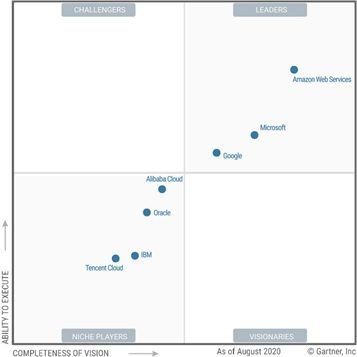Each year, clients and companies alike eagerly anticipate the results of Magic Quadrants. Published by the renowned IT consulting firm Gartner, Magic Quadrants provide excellent resources for key decision makers when looking for new offerings—and accolades for those companies who make the cut.
As in past years, the 2020 Gartner Magic Quadrant for Cloud Infrastructure and Platform Services provides unique insights into the globe’s top providers of cloud offerings.
New changes
As you may have noticed, the scope of this Magic Quadrant has undergone some changes compared to last year’s “Magic Quadrant for Cloud Infrastructure as a Service.” Keeping with the evolution of cloud services, Gartner noted it was necessary to include not only hyper scale cloud providers, but also the broad range of services beyond cloud infrastructure as a service that they offer.
The vendors that are considered in the 2021 Magic Quadrant include IaaS and integrated platform as a service (PaaS) platforms, such as
- Database PaaS (dbPaaS)
- Application PaaS (aPaaS)
- Application developer PaaS (adPaaS)
- Functions as a service (FaaS)
What are Cloud Infrastructure and Platform Services?
Gartner defines cloud infrastructure and platform services (CIPS) as “standardized, highly automated offerings, in which infrastructure resources (e.g., compute, networking and storage) are complemented by integrated platform services.” These can include functions-as-a-service, database, and managed application offerings.
In order to qualify for inclusion in this quadrant, vendors must:
- Sell public cloud IaaS as a stand-alone service
- Be among the top global providers for the relevant segments
- Offer the public cloud IaaS service globally
- Have public cloud IaaS and PaaS services that are suitable for supporting mission-critical, large-scale production workloads
Magic Quadrant for Cloud Infrastructure and Platform Services 2020
Here’s the 2020 Magic Quadrant for Cloud Infrastructure and Platform Services:

(Source)
Results at-a-glance
In order to fully utilize the results of the Cloud Infrastructure and Platform Services Magic Quadrant, it’s necessary to understand each category:
- Leaders: Innovative giants in the industry that successfully execute their vision.
- Challengers: Companies that dominate a large market segment.
- Visionaries: Providers that have a strong vision for the future market.
- Niche Players: Those providers hyper-focused on a small segment.
With these category definitions in mind, below are the results comparing last year’s Magic Quadrant to this year’s final results.
| 2020 Results | 2019 Results | |
| Leaders |
|
|
| Challengers | (none) | (none) |
| Visionaries | (none) | (none) |
| Niche Players |
|
|
Dominant Leaders
Although the three main vendors remained consistent in the Leaders Quadrant from 2019 to 2020, their positions within this quadrant shifted slightly.
Amazon Web Services
With a commanding lead this year, AWS is cementing its place as a strong candidate for edge use and hybrid cloud cases. AWS has:
- The largest share of the worldwide market in both database PaaS offerings as well as IaaS offerings
- The resources and skills to deliver their complete solutions from end-to-end
Generating more than 50% of Amazon’s operating income, it’s no wonder AWS is referred to as a supreme leader.
Microsoft
Next up but not far behind in the Leaders category is Microsoft. Microsoft Azure provides a complete set of end-to-end solutions that address a varying of applications and workloads, perfectly suited for organizations that are already Microsoft-centric. The tech giant leads the hyperscale cloud providers in the application developer PaaS segment, focusing on open-source software with tools like GitHub and Azure DevOps. Microsoft will continue to be a strong competitor to AWS, especially with its efforts to strengthen solutions for containers, serverless, and hybrid environments.
Rounding out the Leader category is Google, known for its open-source contributions TensorFlow and Kubernetes that have completely changed the course of enterprise IT. Enhancing its partnerships with telco providers while building out its hybrid capabilities, Google has seen a major increase in its market share of dbPaaS and IaaS with its Google Cloud Platform (GCP).
With GCP’s exploration into new territory with Anthos, Google’s container and Kubernetes-based middleware layer, it appears that the small gap between GCP and Microsoft Azure will continue to shrink.
New Addition: Tencent
Jumping on the quadrant this year is newcomer Tencent Cloud. Mainly focused on segments in China, Tencent Cloud has expertise in social networking, gaming, and digital e-commerce, with a big focus on gaming companies worldwide. With a larger global IaaS market share than Oracle and IBM, Tencent Cloud has the technical know-how to quickly become a major competitor to its closest domestic challenger, Alibaba Cloud. However, with its limited presence outside of China, it could take some time for this company to move up in the quadrant.
Gartner Magic Quadrant for Cloud Infrastructure and Platform Services 2020
Although the main Leaders in the Cloud Infrastructure and Platform Services Magic Quadrant remained the same, 2020 has forced many companies outside of their comfort zones and pushed cloud services into the market in larger volumes than predicted. With these results, it has become apparent that the capability gap between the major hyperscale cloud providers has begun to narrow. However, the competition for enterprise workloads remains strong.
- Learn where the market stands and where it’s going
- Evaluate vendor strengths
- Make note of vendor challenges
Additional resources
Want to see more Magic Quadrants? Check out these resources:
- The 2020 Gartner Magic Quadrant for Data Center and Cloud Networking
- The 2020 Gartner Magic Quadrant for Application Security Testing
- Gartner® Magic Quadrant™ for ITSM
- The Gartner Magic Quadrant for SIEM
- The Gartner Magic Quadrant for Analytics and Business Intelligence Platforms
These postings are my own and do not necessarily represent BMC's position, strategies, or opinion.
See an error or have a suggestion? Please let us know by emailing [email protected].






